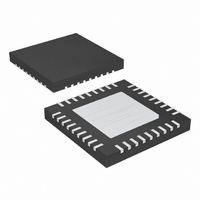MAX9742ETX+ Maxim Integrated Products, MAX9742ETX+ Datasheet - Page 27

MAX9742ETX+
Manufacturer Part Number
MAX9742ETX+
Description
IC AMP AUDIO PWR 20.5W D 36TQFN
Manufacturer
Maxim Integrated Products
Type
Class Dr
Datasheet
1.MAX9742ETX.pdf
(36 pages)
Specifications of MAX9742ETX+
Output Type
2-Channel (Stereo)
Max Output Power X Channels @ Load
20.5W x 2 @ 8 Ohm
Voltage - Supply
20 V ~ 40 V, ±10 V ~ 20 V
Features
Depop, Differential Inputs, Mute, Short-Circuit and Thermal Protection, Shutdown
Mounting Type
Surface Mount
Package / Case
36-TQFN Exposed Pad
Product
Class-D
Output Power
16 W
Thd Plus Noise
0.08 %
Supply Current
15 mA
Maximum Power Dissipation
2.86 W
Maximum Operating Temperature
+ 85 C
Mounting Style
SMD/SMT
Audio Load Resistance
4 Ohms
Minimum Operating Temperature
- 40 C
Lead Free Status / RoHS Status
Lead free / RoHS Compliant
Worst-case supply pumping occurs at high output pow-
ers with low-frequency signals and small load resis-
tances. Since the period is longer for low-frequency
signals, the continuous output current has more time to
pump up the supply rails during each cycle of the
audio signal. Additionally, for most stereo audio
sources the low-frequency audio content (bass) is pri-
marily monophonic. This means both output channels
are basically equal in magnitude and in phase at low
frequencies causing twice as much pump-up current to
flow into the supply bypass capacitors and therefore
doubling the supply pump-up voltages. Assuming
purely sinusoidal output signals, the worst-case supply
voltage increase due to supply pumping can be
approximated using the following equation:
where V
supply rail, V
of the respective supply, f
audio signal, and C
tive supply bypass capacitor. The above equation
shows that increasing the value of the supply bypass
Figure 14. Circuit Configuration for Minimizing Supply Pumping
V
PUMP_MAX
PUMP_MAX
=
SUPPLY
RIGHT-CHANNEL
⎛
⎜
⎝
LEFT-CHANNEL
V
AUDIO INPUT
AUDIO INPUT
Class D Amplifier with Differential Inputs
SUPPLY
2
______________________________________________________________________________________
π
SUPPLY
is the magnitude increase of the
2
is the nominal voltage magnitude
+
+
⎞
⎟ ×
⎠
-
-
A
R
DUAL-SUPPLY CONFIGURATION
V
IN1
OUT
-
⎛
⎜
⎝
is the value of the respec-
= R
f
R
R
OUT
IN_
F
C
C
C
C
IN2
IN
IN
IN
IN
is the frequency of the
, R
F1
×
= R
R
R
R
R
MID
R
IN1
IN2
IN2
IN1
F2
C
SPKR
C
Single-/Dual-Supply, Stereo 16W,
FBL
FBR
1
×
R
R
C
F2
F2
SUPPLY
C
C
INL-
INL+
INR+
INR-
FBR
FBL
⎞
⎟
⎠
FBL
FBR
capacitor decreases the supply voltage variations due
to supply pumping. Using large bypass capacitors
helps minimize supply voltage variations by providing
sufficient supply decoupling at low output frequencies.
To prevent the MAX9742 from entering supply overvolt-
age protection mode at low output frequencies (as low
as 20Hz), use supply bypass capacitors with values of
at least 1000µF for dual-supply operation and 660µF for
single-supply operation.
Using the BTL configuration minimizes the supply
pumping effect since the outputs are driven 180° out-
of-phase with each other. Driving the outputs 180° out-
of-phase causes each half-bridge to pump up and
draw current from opposite supplies, which reduces
the magnitude of the of the supply pumping.
For the single-ended output configuration, the supply
pumping can be minimized by driving the channels
180° out-of-phase and reversing the polarity of one
speaker connection (see Figure 14). Reversing the
polarity of one speaker minimizes any adverse affects
on the audio quality by ensuring that the physical dis-
placement of the speaker cones matches the physical
displacement of the speakers when driven with in
phase signals.
MAX9742
R
R
F1
F1
Alternate Methods for Mitigating Supply Pumping
V
V
DD
SS
OUTL
OUTR
L
L
F
F
C
C
F
F
+
+
-
-
27












